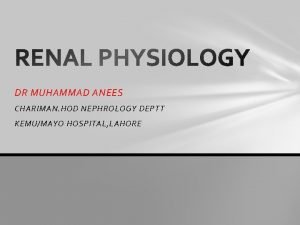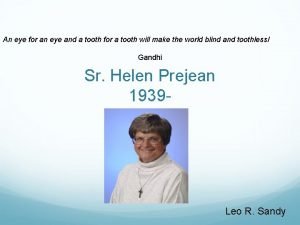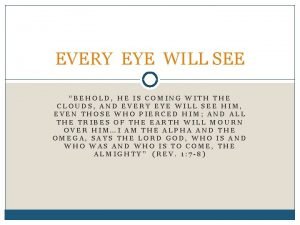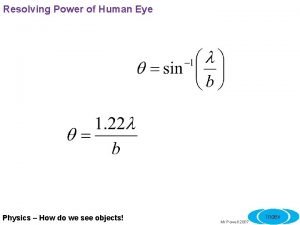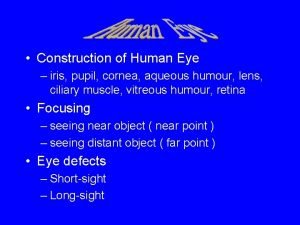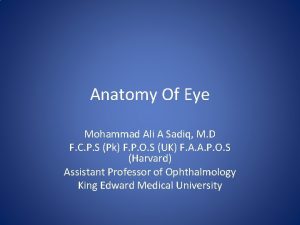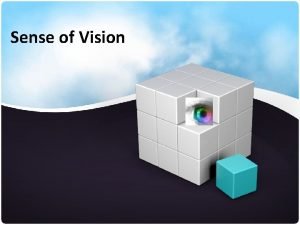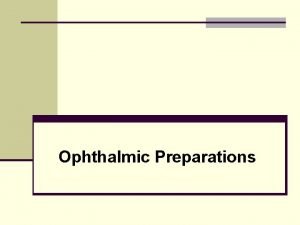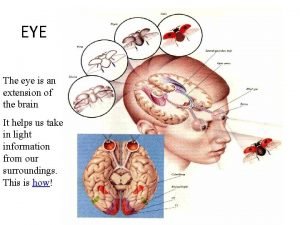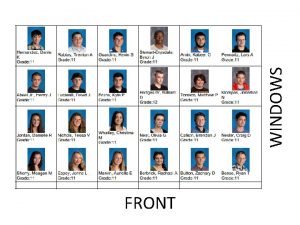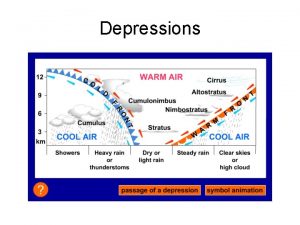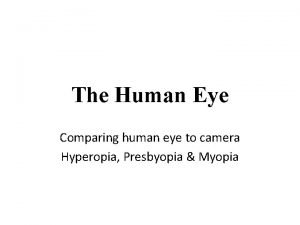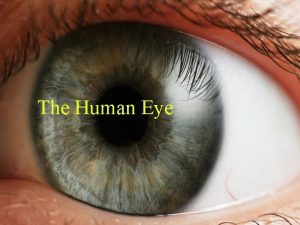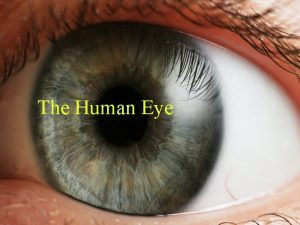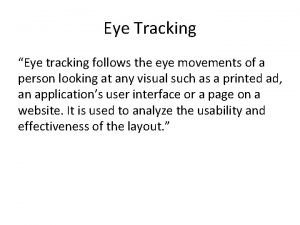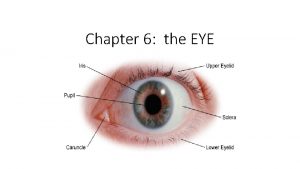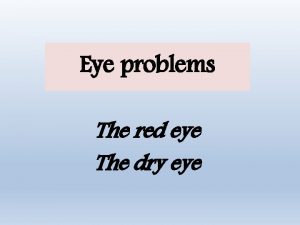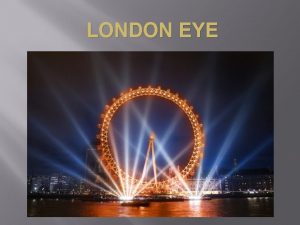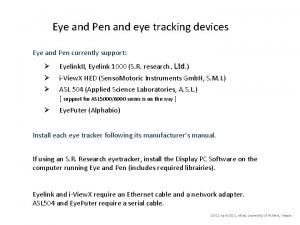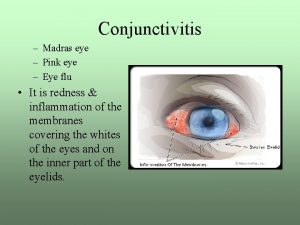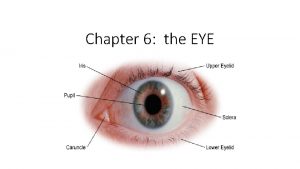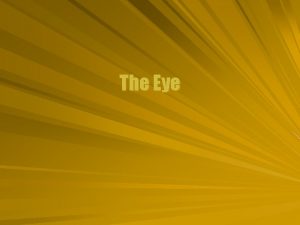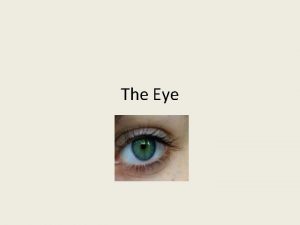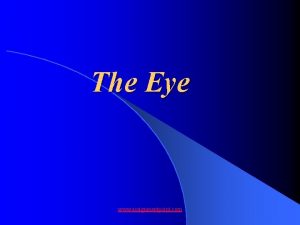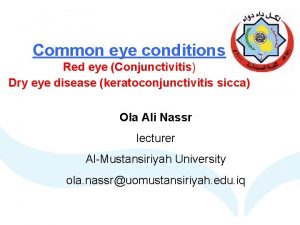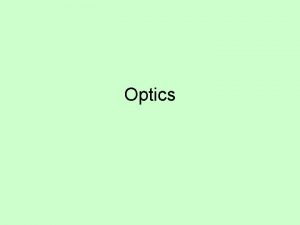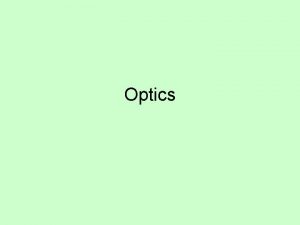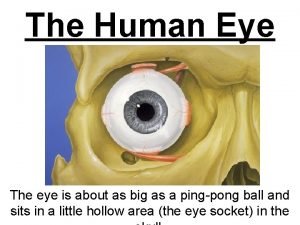The Eye Human Eye Front of the eye
























- Slides: 24

The Eye

Human Eye Front of the eye: refraction and focusing take place Back of the eye: Refracted light forms an image here Brain interprets the image

Front of Eye: Refraction and Focusing Light travels in a straight line through the cornea (lens in front of the eye) Then travels from less dense medium (air) to more dense (cornea) Cornea light rays from object

Front of Eye: Refraction and Focusing Path of light bends toward the normal 80% of refraction takes place where light moves from air to cornea 20% of refraction occurs as light passes through lens Cornea light rays from object

Back of the Eye: Image Formation Light strikes the back of the eye (retina) and forms an image Retina: layer of cells that respond to light Optic nerve light rays from object

Back of the Eye: Image Formation Cells in retina send nerve impulses to the brain through the optic nerve Brain interprets impulses as sight Optic nerve light rays from object

Focusing Lens focuses on near and distant object Circular muscle around the lens contracts and relaxes to change shape of lens Allows lens to refract light to a different extent and focus light from near and distant objects on retina

Focusing on a Distant Object Light from distant object enters eye Muscle Lens around lens is relaxed retains normal shape focuses distant object correctly on retina

Focusing on a Nearby Object Light from nearby object enters eye Muscle around lens is contracted Lens becomes shorter, thicker, and more curved Lens focuses nearby object correctly on retina

Focusing Problems

Hyperopia Far-sightedness; problem seeing close objects Distance between lens and retina too small Light focused behind retina Corrected with converging lenses

Far-Sighted (Hyperopia)

Presbyopia Form of far-sightedness Harder for people to read as they age Lens loses elasticity Also Corrected by glasses with converging lenses

Myopia Near-sightedness Problem seeing objects far away Distance between lens and retina too large Light focused in front of retina Correct with diverging lenses

Near-Sighted (Myopia)

Diseases of the Eye

Astigmatism Eye cannot focus an object’s image on a single point on retina Cornea is oval instead of spherical Causes blurred vision Some types can be corrected with lenses

Glaucoma Group of diseases Affects optic nerve - pressure Loss of ganglion cells Gradual loss of sight and eventual blindness Check eyes regularly Can be treated

Cataracts Clouding forms in lens due to denaturing of lens protein Obstructs passage of light Caused by age, chronic exposure to UV, or due to trauma Removed by surgery

Technology & Refraction

Technology & Refraction Modern technologies in which refraction plays an important role: Artificial Lenses Heads-Up Display (HUD) Wavefront Technology Artificial lens

Artificial Lenses Artificial lenses: used to treat cataracts Cataracts: clouding of the lens that affects vision Treatment: surgery that removes the cloudy lenses and replaces them with artificial lenses Most artificial lenses cannot change shape like natural lenses New artificial lenses have hinges that allows the lens to bend slightly when the muscle around them contracts (A) Relaxed muscle around the artificial lens. (B) When the muscle contracts, it presses on the lens, causing it to bend.

Heads-Up Display (HUD) Refracts light from a projector through a prism Makes an image (computer display) appear in front of the user’s eye Image is an overlay that hovers over the user’s view of the real world Used in wearable head gear by pilots, scuba divers, skiers Users can check speed, distance, depth, and altitude without taking their eyes from their view HUDs can be used to get information about speed, altitude, and direction.

Wavefront Technology Used by eye doctors to map irregularities in the cornea and lens Tracks how a wave front of visible light refracts as it passes through the eye Wavefront anaylzer: directs light waves into a patient’s eye; measures how the light waves travel in and out of the eye Helps doctors perform laser eye surgery and diagnose vision problems Wavefront technology may one day make eye chart tests a thing of the past.
 Dead front vs live front transformer
Dead front vs live front transformer Fronts symbols
Fronts symbols Content page magazine
Content page magazine Hammurabi
Hammurabi How to take worms eye view photos
How to take worms eye view photos An eye for an eye hammurabi
An eye for an eye hammurabi Pdf
Pdf Hammurabi's code activity
Hammurabi's code activity An eye for an eye a tooth for a tooth sister act
An eye for an eye a tooth for a tooth sister act Brown eye blue eye genetics chart
Brown eye blue eye genetics chart An eye for an eye meaning
An eye for an eye meaning Behold he is coming
Behold he is coming Aperture in human eye
Aperture in human eye What is the resolving power of human eye
What is the resolving power of human eye Construction of pupil
Construction of pupil Pars plicata
Pars plicata Introduction of human eye
Introduction of human eye Introduction of human eye
Introduction of human eye The eye parts
The eye parts Hình ảnh bộ gõ cơ thể búng tay
Hình ảnh bộ gõ cơ thể búng tay Slidetodoc
Slidetodoc Bổ thể
Bổ thể Tỉ lệ cơ thể trẻ em
Tỉ lệ cơ thể trẻ em Gấu đi như thế nào
Gấu đi như thế nào Tư thế worms-breton
Tư thế worms-breton






